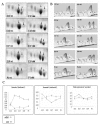Proteomic profiling of the retinal dysplasia and degeneration chick retina
- PMID: 20069063
- PMCID: PMC2805419
Proteomic profiling of the retinal dysplasia and degeneration chick retina
Abstract
Purpose: In our previous paper we undertook proteomic analysis of the normal developing chick retina to identify proteins that were differentially expressed during retinal development. In the present paper we use the same proteomic approach to analyze the development and onset of degeneration in the retinal dysplasia and degeneration (rdd) chick. The pathology displayed by the rdd chick resembles that observed in some of the more severe forms of human retinitis pigmentosa.
Methods: Two-dimensional gel electrophoresis (pH 4-7), gel image analysis, and mass spectrometry were used to profile the developing and degenerating retina of the rdd and wild-type (wt) chick retina.
Results: Several proteins were identified by mass spectrometry that displayed differential expression between normal and rdd retina between embryonic day 12 (E12) and post-hatch day 1 (P1). Secernin 1 displayed the most significant variation in expression between rdd and wt retina; this may be due to differential phosphorylation in the rdd retina. Secernin 1 has dipeptidase activity and has been demonstrated to play a role in exocytosis; it has been shown to be overexpressed in certain types of cancer and has also been suggested as a potential neurotoxicologically relevant target. Its role in the retina and in particular its differential expression in the degenerate rdd retina remains unknown and will require further investigation. Other proteins that were differentially expressed in the rdd retina included valosin-containing protein, beta-synuclein, stathmin 1, nucleoside diphosphate kinase, histidine triad nucleotide-binding protein, and 40S ribosomal protein S12. These proteins are reported to be involved in several cellular processes, including the ubiquitin proteasome pathway, neuroprotection, metastatic suppression, transcriptional and translational regulation, and regulation of microtubule dynamics.
Conclusions: This proteomic study is the first such investigation of the rdd retina and represents a unique data set that has revealed several proteins that are differentially expressed during retinal degeneration in the rdd chick. Secernin 1 showed the most significant differences in expression during this degeneration period. Further investigation of the proteins identified may provide insight into the complex events underlying retinal degeneration in this animal model.
Figures



Similar articles
-
Profiling retinal biochemistry in the MPDZ mutant retinal dysplasia and degeneration chick: a model of human RP and LCA.Invest Ophthalmol Vis Sci. 2012 Jan 25;53(1):413-20. doi: 10.1167/iovs.11-8591. Invest Ophthalmol Vis Sci. 2012. PMID: 22159006
-
A chick retinal proteome database and differential retinal protein expressions during early ocular development.J Proteome Res. 2006 Apr;5(4):771-84. doi: 10.1021/pr050280n. J Proteome Res. 2006. PMID: 16602683
-
Spectral domain optical coherence tomography imaging of the posterior segment of the eye in the retinal dysplasia and degeneration chicken, an animal model of inherited retinal degeneration.Vet Ophthalmol. 2014 Mar;17(2):113-9. doi: 10.1111/vop.12051. Epub 2013 May 22. Vet Ophthalmol. 2014. PMID: 23701506
-
Retinal degeneration and local oxygen metabolism.Exp Eye Res. 2005 Jun;80(6):745-51. doi: 10.1016/j.exer.2005.01.018. Exp Eye Res. 2005. PMID: 15939030 Review.
-
Protein misfolding and retinal degeneration.Cold Spring Harb Perspect Biol. 2011 Nov 1;3(11):a007492. doi: 10.1101/cshperspect.a007492. Cold Spring Harb Perspect Biol. 2011. PMID: 21825021 Free PMC article. Review.
Cited by
-
An Essential Role for Alzheimer's-Linked Amyloid Beta Oligomers in Neurodevelopment: Transient Expression of Multiple Proteoforms during Retina Histogenesis.Int J Mol Sci. 2022 Feb 17;23(4):2208. doi: 10.3390/ijms23042208. Int J Mol Sci. 2022. PMID: 35216328 Free PMC article.
-
Mass spectrometry-based retina proteomics.Mass Spectrom Rev. 2023 May;42(3):1032-1062. doi: 10.1002/mas.21786. Epub 2022 Jun 6. Mass Spectrom Rev. 2023. PMID: 35670041 Free PMC article. Review.
-
The chick eye in vision research: An excellent model for the study of ocular disease.Prog Retin Eye Res. 2017 Nov;61:72-97. doi: 10.1016/j.preteyeres.2017.06.004. Epub 2017 Jun 28. Prog Retin Eye Res. 2017. PMID: 28668352 Free PMC article. Review.
-
The Effect of Chronic Methamphetamine Exposure on the Hippocampal and Olfactory Bulb Neuroproteomes of Rats.PLoS One. 2016 Apr 15;11(4):e0151034. doi: 10.1371/journal.pone.0151034. eCollection 2016. PLoS One. 2016. PMID: 27082425 Free PMC article.
-
Measurement of the photoreceptor pointing in the living chick eye.Vision Res. 2015 Apr;109(Pt A):59-67. doi: 10.1016/j.visres.2015.01.025. Epub 2015 Feb 23. Vision Res. 2015. PMID: 25722105 Free PMC article.
References
-
- Hartong DT, Berson EL, Dryja TP. Retinitis pigmentosa. Lancet. 2006;368:1795–809. - PubMed
-
- Jones BW, Watt CB, Frederick JM, Baehr W, Chen CK, Levine EM, Milam AH, Lavail MM, Marc RE. Retinal remodeling triggered by photoreceptor degenerations. J Comp Neurol. 2003;464:1–16. - PubMed
-
- Phelan JK, Bok D. A brief review of retinitis pigmentosa and the identified retinitis pigmentosa genes. Mol Vis. 2000;6:116–24. - PubMed
-
- Hanash S. Disease proteomics. Nature. 2003;422:226–32. - PubMed
Publication types
MeSH terms
Substances
Grants and funding
LinkOut - more resources
Full Text Sources
